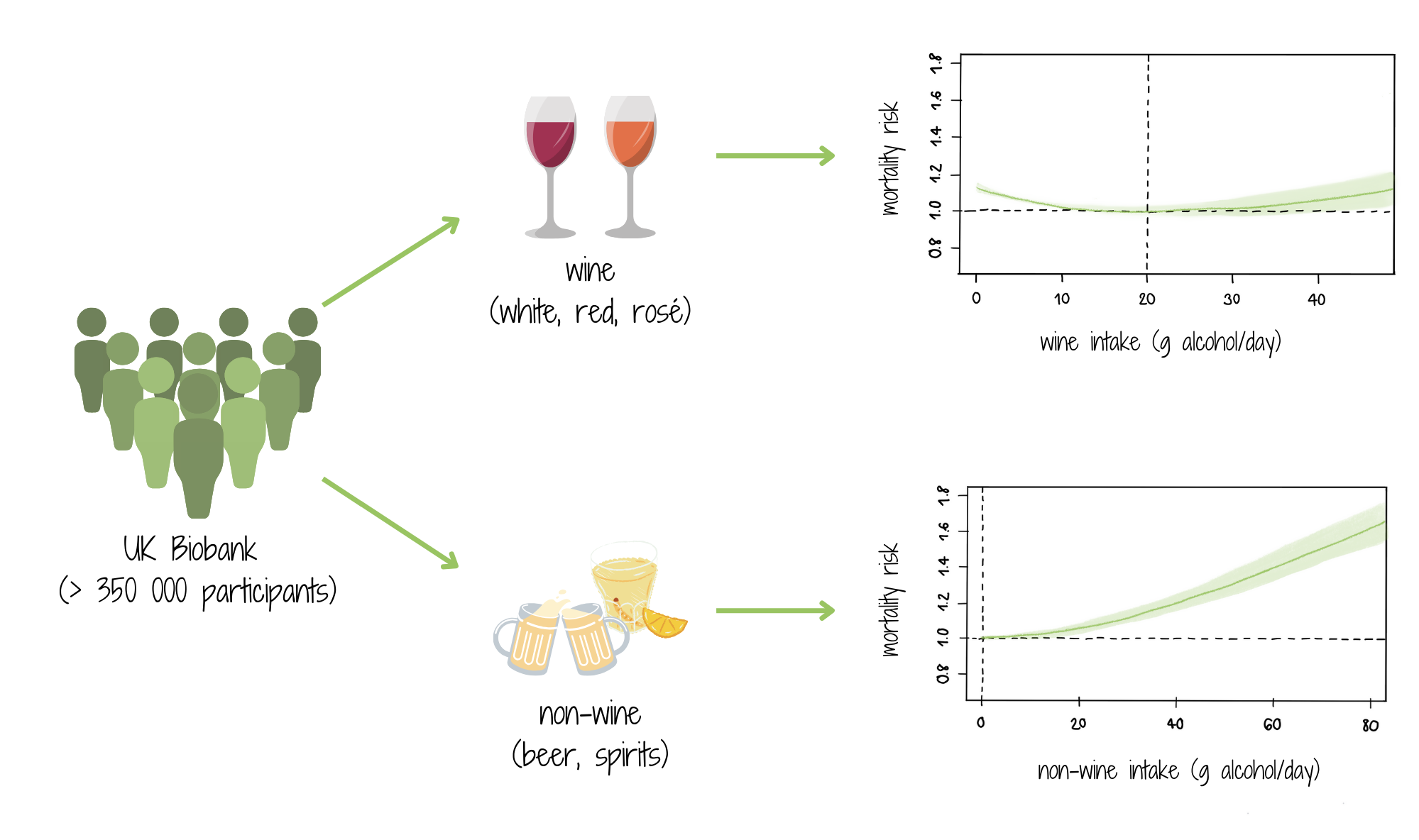
Major points:
- A scientific study conducted by the Neatic team analyzed over 350 000 people to determine whether alcohol consumption – wine and other alcoholic drinks such as beer and spirits (referred to as non-wine in the study) – is associated with mortality.
- The lowest mortality risk is observed with wine consumption of 20 grams of alcohol per day (equivalent to 0.25 liters of wine); mortality rates increase with higher amounts. For non-wine consumption, non-drinkers have the lowest mortality risk, which increases steadily with the amount consumed.
- This study supports the Neatic recommendation to drink alcohol only in small amounts, as higher amounts are associated with an increased risk of death. Drinking low to moderate amounts of wine (up to 0.25 liters per day) possibly reduces mortality risk to some extent. However, one should not start drinking wine solely for this reason.
What do we know about alcohol consumption?
The alcohol intake is expressed in grams per day. The German Society for Nutrition (DGE) recommends a maximum intake of 10 grams per day for healthy women and 20 grams per day for healthy men. 10 grams of alcohol is equivalent to approximately 0.3 liters of beer, 0.125 liters of wine, 0.1 liters of sparkling wine, or 4 cl of spirits. International recommendations for maximum alcohol intake are often in the range of 10 grams to 20 grams per day. For example, the National Health Service (NHS) in the UK recommends alcohol consumption of less than 16 grams per day for both genders.
Several studies suggest that there are differences between wine and other alcoholic beverages such as beer and spirits (referred to as non-wine). Moderate wine consumption is often associated with positive health effects. However, guidelines do not recommend starting or increasing alcohol consumption to potentially gain health benefits.
What is the study investigating?
The study examines whether there is an association between wine and non-wine alcohol consumption and mortality. More than 350 000 participants from a large British study were examined. More than 20,000 participants had died by the time the study was done. In addition to alcohol consumption, other factors influencing mortality risk were taken into account, such as age, gender, income, and education.
What did the study discover?
Wine consumption was associated with mortality risk in a U-shaped fashion. U-shaped means that the lowest risk of death was 20 grams of alcohol per day (equivalent to 0.25 liters of wine). People who consumed no alcohol or less than 20 grams of alcohol per day had a higher risk of dying, as did people who consumed more than 20 grams of alcohol per day.
In contrast, the risk of death was lowest for participants who did not drink any non-wine alcoholic beverages and rose with increasing consumption of non-wine.
The study also examined whether alcohol consumption was associated with specific types of death. It was found that there was also a U-shaped relationship between wine consumption and death from cardiovascular disease (e.g., a heart attack). However, drinking wine did not show an association with the risk of dying from cancer. Consumption of non-wine beverages increased the risk of dying from both cancer and cardiovascular disease.
What is the conclusion of the study?
This study supports the recommendations of professional societies and of Neatic to consume alcohol only in small amounts because higher amounts are associated with an increased risk of death. Small to moderate amounts of wine (up to 0.25 liters per day) may reduce mortality somewhat. However, no one should start drinking wine just for that reason. For non-wine alcoholic beverages such as beer and spirits, mortality increases with increasing dose, and there is no evidence for positive effects at low consumption levels.
Bibliography:
Bundeszentrale für gesundheitliche Aufklärung: Häufige Fragen zum Thema Alkohol. Available online at https://www.kenn-dein-limit.de/haeufige-fragen-zum-thema-alkohol/, last checked 06.03.2024.
Department of Health (2016): UK Chief Medical Officers‘ Alcohol Guidelines Review. Available online at https://assets.publishing.service.gov.uk/government/uploads/system/uploads/attachment_data/file/489795/summary.pdf, last checked 06.03.2024.
Deutsche Gesellschaft für Ernährung e.V. (2000): Referenzwerte Alkohol. Available online at https://www.dge.de/wissenschaft/referenzwerte/alkohol/, last checked 06.03.2024.
Schaefer, Sylva M.; Kaiser, Anna; Behrendt, Inken; Eichner, Gerrit; Fasshauer, Mathias (2023): Association of alcohol types, coffee and tea intake with mortality: prospective cohort study of UK Biobank participants. In: Br J Nutr, S.115-125. DOI: https://doi.org/10.1017/S000711452200040X.
